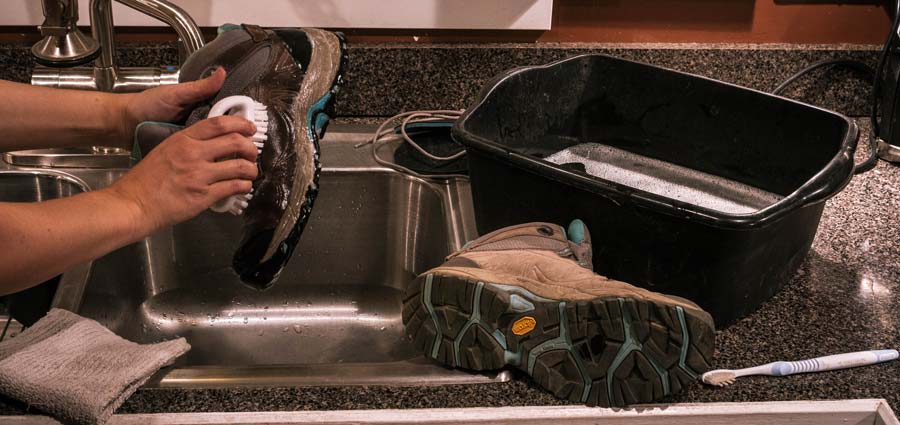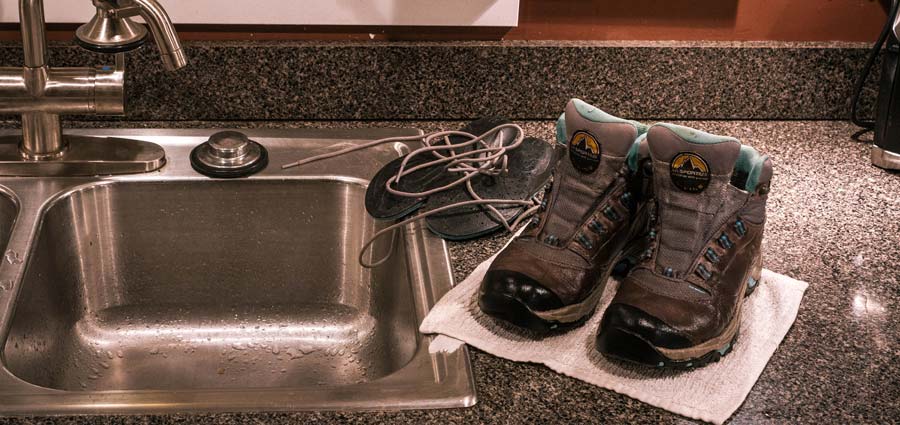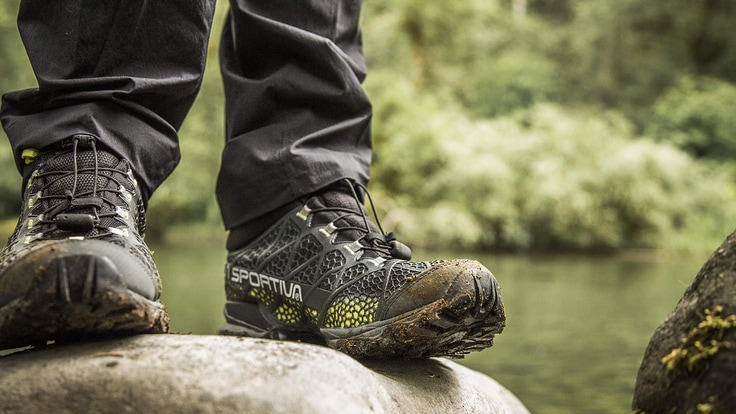Hiking boots are built to take muddy, gritty trails in stride. But that doesn't mean it's a great idea to toss your mucky companions in the closet and forget about them. Clean them faithfully and you'll enjoy many years on the trail together and reduce the need to replace them prematurely. If you're too tired immediately after a hike, then clean 'em the following day.
Ignoring cleaning breaks down your boots in a couple of ways:
- Every time your boots flex, particles of dirt, grit or sand creep deeper into their leather and fabric, grinding away like sandpaper.
- Mud sucks moisture from leather as it dries, leaving your boots' leather less pliable and speeding up its aging process.
What you'll need for cleaning your hiking boots:
- A special boot brush, an old vegetable brush or toothbrush
- Specialized boot cleaner, saddle soap or a mild solution of dishwashing soap and water
Cleaning Hiking Boot Uppers

Remove laces prior to cleaning. Use a brush to gently remove dust and dirt. For a more thorough cleaning, add running water and whatever boot cleaner you have chosen.
Some additional boot cleaning tips:
- Though most footwear cleaners can be used on a range of materials, always double-check to be sure your cleaner is OK for use on your boots—and be sure to read and follow the directions.
- Do not use bar soap or detergents; many contain additives that can be harmful to leather or waterproof membranes.
- To clean mold, use a mixture of 80 percent water and 20 percent vinegar.
- Always rinse your boots thoroughly with clean water afterward.
- Never put boots in a washing machine because it can damage them.
- If you plan to waterproof your boots, do it while they're still wet. Most boots are waterproof when you first buy them, so you don't need to waterproof them until you start to notice that water drops no longer bead up on the surface. For details, read How to Waterproof Your Hiking Boots.
Cleaning Hiking Boot Outsoles
Though caked-on mud won't damage your boots, removing it will restore them to full traction. Also, having clean outsoles prevents you from transporting invasive species from one hiking area to another.
Brush the outsoles vigorously and dislodge pebbles that are stuck. For stubbornly caked-on dirt, soak just the outsoles and then use a hose to power-wash the gunk away.
Hiking Boot Drying and Storage Tips

- Remove insoles and let them air-dry separately from the boots.
- Dry boots at normal temperature in a place with low humidity.
- Do not use a heat source (fireplace, campfire, wood stove, radiator, heater, etc.). High heat weakens adhesives and prematurely ages leather.
- For quicker drying, use a fan.
- You can also stuff newspaper into the boots to speed drying; change the paper frequently (whenever it's damp).
- Store boots where temperatures are stable and normal. Do not store boots in attics, garages, car trunks or any damp, hot or unventilated place.
Conditioning Your Boots
Use a conditioner when your boots' full-grain leather (leather that looks smooth rather than rough on the outside) appears dry or cracked. Other types of leather—suede and nubuck—don't require conditioning. Conditioner can also be used if your new full-grain leather boots need to be broken in quickly.
Use a conditioner judiciously. Healthy leather functions best when moisturized. Too much conditioner, though, makes boots too soft, reducing the support they provide.
Do not use Mink Oil or similar oils designed for industrial boots; it over-softens the type of dry-tanned leather used in hiking footwear.



